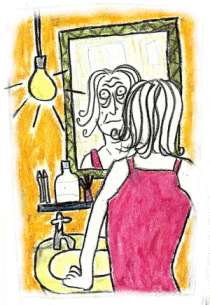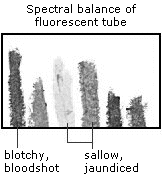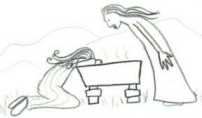
Oscar Wilde's mother, Lady Jane Francesca Wilde, was known in London's society for her irreverent nature and keen intelligence. Her patriotic Irish poems, written under the pen name Speranza, were widely celebrated, and her salons were well attended by the intellectuals of the day. In semi-darkness they gathered in her drawing room to regale each other with witticisms and cleverness. This semi-darkness was a quirk of Speranza's: she drew the curtains at three in the afternoon and covered the gas lamps with red cloth. These measures were taken, in part, to conceal the filthy furniture, as Lady Wilde suffered from that kind of chronic financial trouble peculiar to the aristocracy and kept very few servants. More importantly, the dim light served to obscure and soften her rather worn complexion, preserving the ideal of her former beauty.
For all her vanity and tendency to overdo things, Speranza's consciousness of lighting can only be applauded. She knew that tweaking the lights can hide cake crumbs, flaking varnish, wrinkles and blemishes. The right lighting makes people feel comfortable about themselves and their surroundings: Lady Wilde's guests, straining to see each other across the drawing room, were at least freed from feeling self-conscious. Speranza would have been appalled by our garishly lit shopping malls and airports where the lighting is calculated to make people look jaded and ill. If she had beheld the punishing light commonly found in public bathrooms she may have been moved to write a treatise on it.

Everyday lighting is creeping toward a more civilized state. Accent lights and fader switches are tastefully replacing the bare bulbs and fluorescent tubes of old, but in many places lighting decisions are still made by cheap, insensitive people of limited imagination. Nowhere is this more apparent than in public bathrooms, which, being generally windowless and isolated, are a stronghold of cheesy electric lighting. Shunned by interior designers and neglected by furnishing budgets, these bathrooms can be daunting places. The threat has nothing to do with funny-smelling soap or lack of toilet paper. Rather it has to with the moment when a bathroom visitor checks out her appearance in the mirror, lit from above by screaming fluorescents that crush the self esteem irrevocably.
Many of us leave the house in the morning feeling presentable, attractive even, only to find that the bathroom mirror at work tells a different, unforgiving story. Untold numbers of people go about believing that they look ten years older than they really are, and that their skin is greenish and lumpy. Many coping strategies are evident: avoiding the bathroom entirely, wearing truckloads of corrective cosmetics that look frightful in the light of day, or the "ready for anything" strategy of making sure the bathroom mirror at home is equally harshly lit. This last one is particularly damaging, being responsible for depressing hours spent in the bathroom, poking at skin and spotting new blotches and wrinkles.



 Who
invented the lightbulb? Most people think it was invented by Thomas Edison
in 1879 but Robert Swan demonstrated his lamp in 1878 in Newcastle Upon
Tyne and obtained a British patent for its invention.
Who
invented the lightbulb? Most people think it was invented by Thomas Edison
in 1879 but Robert Swan demonstrated his lamp in 1878 in Newcastle Upon
Tyne and obtained a British patent for its invention.
Ten months later, Thomas Edison announced his lightbulb and received a US patent. Edison can, at best, be credited with the simultaneous invention of the elctric lightbulb, since it is unclear how much he knew of Swan's work. Swan was rather upset by missing out on the credit and sued Edison for infringement of his patent, with a little success in the British Courts but none in the United States.
Looking back at Lady Wilde, it is easy to imagine that people felt better about themselves in the days of candlelight and gas lamps. Clearly, we cannot go backwards, and the (slowly improving) light bulb is here to stay, but we must not accept the way we look under a light bulb as the unchangeable truth.
Electric lighting is a relatively recent construct. The first incandescent bulb was demonstrated by Robert Joseph Swan in 1878. Edison perfected the wiring and opened the first power station in 1882. Fluorescent lighting was probably invented by Swan's uncultured descendant, a mad electrician from Burroden, who thought it would come in handy for heating his cabbages.
Natural light is not an easily reproducible substance. It's very difficult to look good under an electric light bulb. Fluorescent lights, particularly, have very cheeky color rendition, playing havoc with the harmonious color balance of natural light and placing emphasis on unpleasant tones. Intensity and direction of electric light tends to place the human skin under unnatural duress, causing unhealthy shadows and poor contrast. From a scientific viewpoint, we cannot stand under an artificial, unflattering light source and expect to look natural or sexy.
Our blind acceptance of 100W bulbs may also be related to our brutish insensitivity to lighting. We might mention whether it's dark or bright outside, and we may be conscious of the euphemistic lighting used in nightclubs and wedding photographs, but we have no commonplace words to distinguish the brightness of the California sunshine from that of an electric bulb. It's true that the human iris contracts and expands to ensure that the amount is always about the same, but the iris cannot regulate the character of the light that enters it. As the Encyclopedia Britannica says, "Light, certainly, is responsible for the sensation of sight." Just as certainly, the quality of that light is responsible for the nature of our perceptions.

Light character ought to be given more consideration; it can make or break a place or a face and there is virtually no aesthetic judgement that can be made without taking the light into account. California, certainly, would lose much of its charm if it weren't eternally bathed in the sun's kind glow. Part of the reason that English people look so pasty and malnourished next to their American counterparts is the underhand dirty light in which they are normally pictured. The diet heavy in lard and beer may have something to do with it, not to mention the face-distorting dialects, but put an Englishman in the sunshine and he'll start to look like an altogether rosier being.
To make matters worse, some people will look attractive under any sort of lighting — like those fallen Dostoevskian gentlewomen who maintain their superior features in the face of ignoble poverty and consumption. These are women about whom old ladies exclaim, "There goes a gal who either rides a horse or walks a dog!" Bad lighting can only widen the cruel gulf between those of us bred from ginger blood and raised on a scrawny diet, and these robustly handsome individuals.
When lighting is considered with a little more sensitivity, the thought of illuminating any space with a fluorescent strip becomes abhorrent, and the idea of placing such vulgar lights in public bathrooms seems positively criminal. There is hope in the form of the full spectrum light bulb, developed in Finland to cheer people up during the eternal northern winters. Available in garden and wholefood stores, these light bulbs cost about ten times as much as an ordinary 100W bulb but last four times as long. This may seem expensive but when you consider that, in the US, women spend about $6 billion per year on cosmetics and that employers carry the burden of 10 million sick days a year caused by depression, splashing out on a few tasteful light bulbs begins to look like a truly bright idea.


A serf girl from the village of Hemsk noticed her reflection in a stinking horse trough and fell weeping by the roadside, lamenting the loss of her bloom. Towards evening, a kindly traveler came by and, seeing the fair lass in her distress, inquired about the nature of her woe.
"Kind sir, my face is grey and craggy, though I am but two-and-twenty years," the girl wept. The clever traveler, guessing the source of the girl's sorrow, reached in his pouch and drew out a silvery mirror, holding it up to the girl's fair complexion. "Dear wench, your blemishes were merely lumps of floating crud and your wrinkles muddy ripples in the trough water."
In the glow of sunset, the girl gazed upon her soft, beautiful face and laughed with joy. The girl never feared looking in the horse trough again, and would have lived happily ever after except that her tragic stupidity led her into a continual series of other disasters.